Sometimes a picture speaks volumes. Below on the left is a photo I grabbed from a video that I shot of my 7 year-old son running down the road barefoot in front of my house last weekend (he spends most of the summer either barefoot or in Crocs). On the right is a picture of a boy who has never worn shoes running down a dirt road in the Nandi District of Kenya (filmed by Daniel Lieberman). Both are frozen at the moment of initial contact between the foot and the road. Love this photo.
Getting my son to run without being a ham in front of a camera is a major challenge, so some of these clips may not be his most natural form, but he did exhibit some variability. Here’s a nice midfoot (full-foot) strike.
Here’s another forefoot:
And here’s a 1964 Abebe Bikila style mild heel strike.
I like these photos because they show that footstrike can be variable a bit to either side of the midfoot (particularly at slower paces), but I never see the 45 degree angle between his sole and the ground that I see in some shod runners. If I had to guess, if I could get continuous footage of him and not just have him run a short distance by the camera (where he is prone to showboating), I’d mostly see forefoot strikes on the asphalt. My next challenge is to figure out how to rig my camera to my bike so I can get a longer clip…
My 5 year-old daughter, on the other hand, seems to be a pretty consistent midfooter when barefoot (maybe slight forefoot in the second landing). She’s also mostly barefoot in the summer, but sadly is already showing a taste for high-heels (she has a bit of a fashionista in her). One cool thing about the photos below is that you can see that when she’s running faster (top 2 photos), her thigh angles further forward, but in all cases her lower leg is more or less perpendicular to the ground at contact:
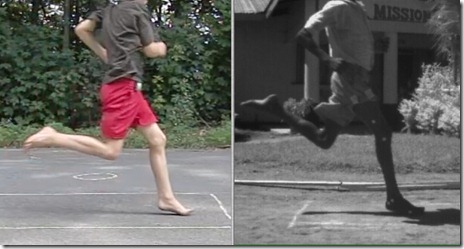

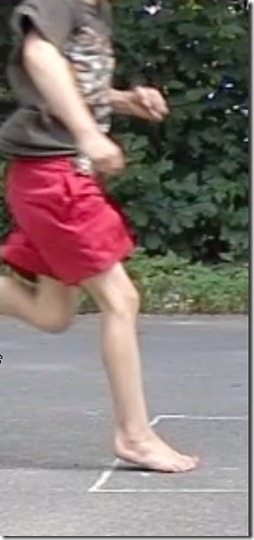
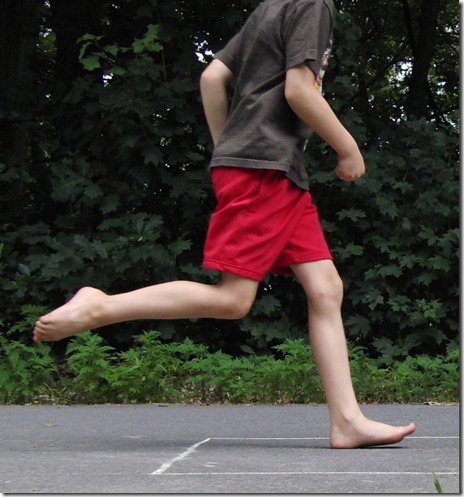
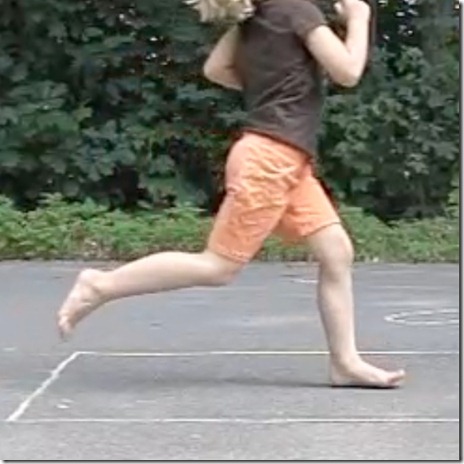
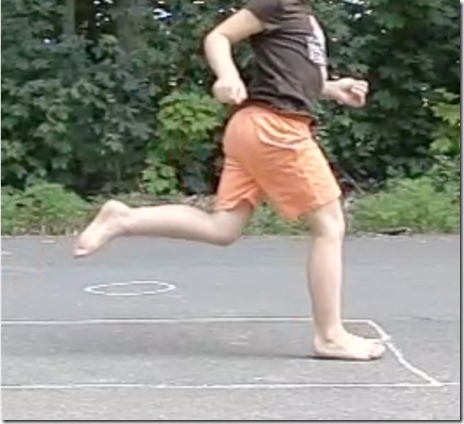
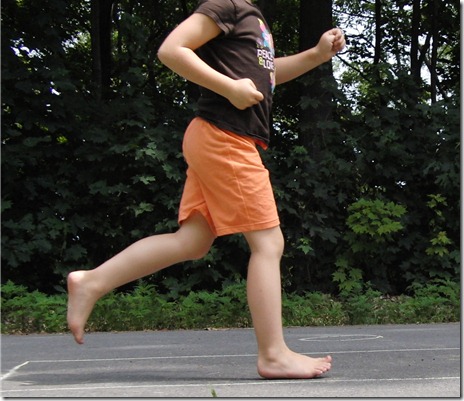
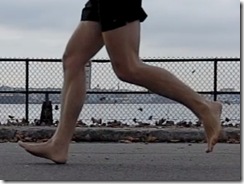
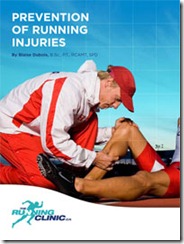
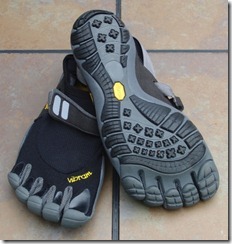

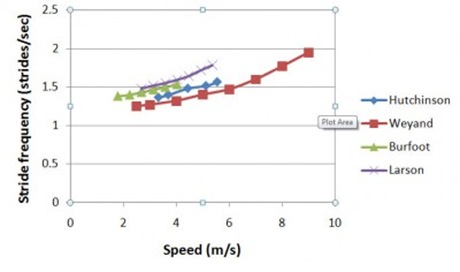














I like the two photos together. Frame it for the living room.
I love watching my 3 and 5 year old girls run. We’re going to try and make sure they stay mid/fore-foot runners. My 5 yo is getting Merril Barefoot shoes for kindergarten.
Man your kids are patient with a geeky dad ;-)
Your pictures remind me of what I was observering whilst on holiday at the seaside in Nomandy, France. On the wooden and concrete promanad you’d see lots of kids and parents jogging to and fro whilst playing, sometimes shod sometimes barefoot. Almost everyone I saw was landing with their shin pretty well vertical – I don’t recall seeing anyone overstride. I’d guess most likely not regular runners, just average folks at the sea-side having fun.
This observation surprised me given just how common overstridding looks to be during races with recreational runners, where over stridding with pronounced heel strike seems to be almost the norm.
Might the difference that happens when people start training in built up trainers and just fall into the habit of over stridding? It would be interesting study to take a large set of new runners planning on training for a particular event and track them as they train – have half prescribed low heel drop shoes, while the rest can purchase what the local running shop might “prescribe”. Has any study been done before?
I’m curious as it be useful to know just how the typical gait we see at events is established. I suspect that the overstridding and pronounced heel strike isn’t a default from the start of training, but something that is heavily influenced by type of footware one selects.
Robert – would be an interesting study, and as my recent post on Lieberman’s
acclimation study shows, footwear can change gait over time. I even see
things change the moment I put shoes on my kids.
Pete
I have observed this in kids for decades.This makes perfect sense, shoes are like straight jackets, Tell me how strong would your biceps be if you coulkd never do a curl? – However for us adults after decades of allowing our feet to atrophy because of poor footwear choices and poor shoe designs, the harm we have done to our feet is not going to get reversed by hitting the gym or the roads barefoot 3 x a week for 40minutes. However this is a fantastic start. People need to compliment these barefoot activities with a biofeedback insole system (see barefoot science for example). Let’s face it for most of us we are in shoes 60-70% of the time during our waking hours – during that time our feet are subjected to the harmful forces created by footwear. Doing something proactive in our shoes during that 60-70% of the time will make being barefoot more enjoyable and achievable at a faster rate. Keep being barefoot as much as possible but also do something to combat the negative effects of our shoes.
I have observed this in kids for decades.This makes perfect sense, shoes are like straight jackets, Tell me how strong would your biceps be if you coulkd never do a curl? – However for us adults after decades of allowing our feet to atrophy because of poor footwear choices and poor shoe designs, the harm we have done to our feet is not going to get reversed by hitting the gym or the roads barefoot 3 x a week for 40minutes. However this is a fantastic start. People need to compliment these barefoot activities with a biofeedback insole system (see barefoot science for example). Let’s face it for most of us we are in shoes 60-70% of the time during our waking hours – during that time our feet are subjected to the harmful forces created by footwear. Doing something proactive in our shoes during that 60-70% of the time will make being barefoot more enjoyable and achievable at a faster rate. Keep being barefoot as much as possible but also do something to combat the negative effects of our shoes.